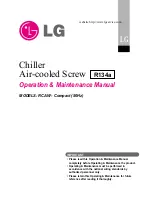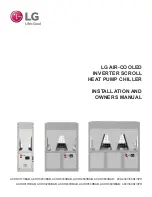
16
CHA - CHA/K
5
INSTALLAZIONE
5.1
SCELTA DEL LUOGO DI INSTALLAZIONE
Nella scelta del luogo di installazione si dovrà tenere
conto di:
-
Peso dell’unità:
La soletta di appoggio dell’unità deve essere
perfettamente orizzontale ed in grado di sop-
portare il peso in funzionamento dell’unità.
È opportuno costruire una soletta di supporto di dimen-
sioni proporzionate all’unità. Ciò si rende in particolar
modo necessario quando l’unità deve essere posta su
terreno instabile (giardini, terreni di riporto, ecc.).
La soletta deve:
• appoggiare su opportune fondamenta, avere un’altezza,
rispetto al terreno circostante, di circa 10-15 cm;
• essere orizzontale ed in grado di sopportare circa
il 200% del peso di esercizio della macchina. Si
consiglia di interporre una guarnizione di sughero
adeguatamente sigillata lungo il perimetro.
-
Spazi:
È necessario verificare che gli spazi di rispetto
riportati sul quaderno tecnico dell’unità siano
lasciati liberi.
Ridurre lo spazio richiesto può significare difficoltà o
impossibilità di effettuare le operazioni di manutenzione
e/o malfunzionamento dell’unità a causa di riduzione
della portata d’aria che investe la batteria condensante
o di ricircolo della stessa.
Si fa presente che non sono ammessi osta-
coli quali tettucci, pensiline o coperture in
genere al di sopra della macchina.
Si tenga presente che le unità a pompa di calore dan-
no luogo a formazione di ghiaccio e condensa che
si riversa sul pavimento antistante l’unità. Si dovrà
pertanto provvedere a raccogliere e drenare l’acqua di
condensa e sbrinamento per evitare che il pavimento
diventi sdrucciolevole.
Tutta la zona di rispetto dovrà essere in-
terdetta, fatta eccezione per gli operatori e
manutentori addetti alla macchina.
-
Rumore:
Durante il suo funzionamento, l’unità genera del
rumore, evitare pertanto l’installazione in ambienti
riverberanti.
L’unità dovrà essere posizionata con il lato batteria
rivolto nella direzione in cui la rumorosità è meno
critica.
-
Venti predominanti:
Il vento può alterare le condizioni di funzionamento,
per minimizzarne gli effetti si consiglia di posizionare
l’unità con il lato lungo parallelo alla direzione dei venti
predominanti.
-
Vibrazioni:
Benché le macchine trasmettano al terreno un basso
livello di vibrazioni, è in ogni caso consigliabile frapporre
fra il basamento delle stesse ed il piano di appoggio
un nastro di gomma rigido.
Quando si rende necessario un isolamento maggiore
è opportuno l’utilizzo di supporti antivibranti (in gomma
o a molla)
5
INSTALLATION
5.1
CHOOSING THE INSTALLATION SITE
When choosing the installation site the following points
should be considered:
-
The weight of the unit:
The supporting surface under the unit must
be perfectly horizontal and able to withstand
its operating weight.
A supporting surface with an appropriate area should be
built. This is particularly important if the unit is installed
on unstable ground (gardens, embankments, etc.).
The supporting surface must:
• lie on suitable foundations and be about 10-15 cm
higher than the surrounding ground;
• be horizontal and able to withstand about 200% of
the weight of the unit in operation. A suitable sealed
layer of cork should be placed along the perimeter.
-
Spaces:
Make sure that sufficient free space, as in
-
dicated on the technical book, is left around
the unit.
Less space will make it difficult or impossible to carry
out maintenance operations and/or lead to faults in
the unit due to the reduction in the air flow on the
condenser coil or its recirculation.
Please note that obstacles such as can-
opies, shelters or coverings in general are
not permitted.
Please note that the heat pump units cause ice and
condensation to form and drain onto the floor in front
of the unit. This water must therefore be collected and
drained to prevent the floor from becoming slippery.
People may not enter the unit area unless
they are authorised operators and mainte-
nance personnel.
-
Noise:
The unit generates noise while it’s working; do not
install it in reverberating rooms. The unit must be po-
sitioned with the coil side facing the direction where
noise is less critical.
-
Prevailing winds:
Wind may alter operating conditions; to minimise its
effects the unit should be positioned with the long side
parallel to the direction of prevailing winds.
-
Vibrations:
Although the units transmit a low level of vibrations
to the ground, a sheet of rigid rubber should always
be placed between the unit base and the supporting
surface.
If greater insulation is required, vibration moisting sup-
ports should be used (in rubber or with springs).
















































